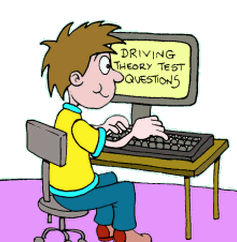Road conditions: driving in rain
Driving in rain is something that you can be sure you will experience regularly once you are an actual driver, although depending where you live and the time of year you learnt, you might have experienced it surprisingly little whilst you were learning to drive.
Now, when it comes to driving in the rain, braking is most clearly affected. Indeed if you have to break quickly it can take twice or longer for you to be able to stop the car. The reason for this is that the grip of the tyres on the road surface is less effective when it is wet, and so in addition the wheels can lock up.
This means that you should brake less strongly than you would in ordinary road conditions, and pro rata you should adjust your speed to the road conditions and go more slowly in rain than you normally would.
If there are any visibility issues at all from the rain even if it is light, then as a first step you should use your headlights on dipped. And make sure the windscreen is always clean: some learners have never actually needed to put the wipers on until they have passed their test, and indeed to squirt the windscreen also to clean it.
Sometimes you might have to drive through water on the road, such as a ford.
Common sense tells you to look for the shallowest point in it, as far as you can tell, and indeed that is what you should do, before driving through it slowly. When doing so you should select first gear and keeping the engine speed relatively high so that you do not risk stalling.
It is recommended that whenever you've been through water like that you then test the brakes afterwards to ensure that they are not affected: to do this simply drive slowly with one foot on the accelerator on the other pressing gently on the brake. This will let you test that the brakes are still working well.
Related Articles...
Test your Driving Theory
Want to test your driving theory knowledge? We have all the multiple choice revision questions for car drivers together with a range of hazard perception clips.
With our unique feedback and...
Motorway Driving Tips
Driving on a motorway for the first time can be both exciting and a little daunting - exciting as it is something new whilst daunting as you won't have experienced driving on a motorway before...
How to deal with bus lanes
If you see a bus lane then you will see a range of different attitudes from drivers. Mainly there will be frustration that they are stuck in a huge queue and there is a perfectly good lane that is...
How to book your driving theory test
There is now an online booking system in place that will allow you to book a driving theory test online.
There are also other ways to book a driving theory test: over the phone and you can...
Regular car checks to perform
In addition to the daily checks that you should perform on core elements of your car such as the tyres (see article entitled 'what to check on your car daily') there are various other elements that...
Your ignition warning light
When you turn on the electrical circuits in your car, then the ignition warning light will come on: make sure that this does indeed happen.
Once the engine itself is started, then the ignition...
How Pass Plus Works
What does pass plus contain? Well, it has six different modules and each of these ones focuses on a different set of conditions in which you might have to drive. These are in and around the town,...
Working out what a road sign means
There are many signs that you will see day in day out as a driver and are obvious to understand. For instance signs that tell you the maximum speed limit on the road you're on. For some reason,...
Vehicle's registration certificate
A vehicle has a document called a V5C, and this is the registration certificate for the vehicle. However this document by itself is not alone proof that the person selling you a vehicle actually...
What to expect at a hazard perception test
The test has fourteen different clips, as outlined in the article entitled 'how to pass the hazard perception test'.
Each of those clips starts counting down from ten to zero, in order to...
Back to home page of driving theory test questions

